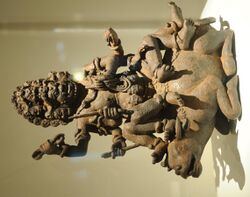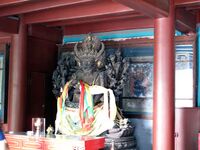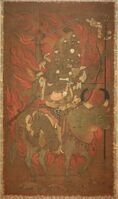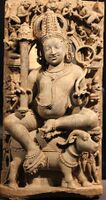Yamantaka
Topic: Unsolved
 From HandWiki - Reading time: 5 min
From HandWiki - Reading time: 5 min
thumb|291x291px|Carved cliff relief of Yamāntaka, one out of a set depicting the Ten Wisdom Kings, at the Dazu Rock Carvings in Chongqing, China . 7th century.Yamāntaka (Sanskrit: यमान्तक Yamāntaka) or Vajrabhairava (Tibetan: གཤིན་རྗེ་གཤེད་, རྡོ་རྗེ་འཇིགས་བྱེད།, Wylie: gshin rje gshed; rdo rje 'jigs byed; simplified Chinese: 大威德金刚; traditional Chinese: 大威德金剛; pinyin: Dà Wēidé Jīngāng; Korean: 대위덕명왕 Daewideok-myeongwang; Japanese: 大威徳明王 Daiitoku-myōō; Mongolian: Эрлэгийн Жаргагчи Erlig-jin Jarghagchi) is the "destroyer of death" deity of Vajrayana Buddhism.[1] Sometimes he is conceptualized as "conqueror of the lord of death".[2] Of the several deities in the Buddhist pantheon named 'Yamāntaka', the most well known, also called as 'Vajrabhairava' belongs to the Anuttarayoga Tantra class of deities popular within the Gelug school of Tibetan Buddhism.
Etymology
Yamāntaka is a Sanskrit name that can be broken down into two primary elements: Yama (यम), –the god of death; and antaka (अन्तक) –destroyer.[3] Thus, Yamāntaka means “Destroyer of Death” or "Conqueror of Death".[2][4]
While Yamāntaka is therefore Yama's nemesis, his representation mirrors Yama in many ways: he too often rides a buffalo and often depicted with a buffalo's head.
Because of this mirroring of appearance and similarity in name, it is not hard to find texts and books (which would appear to be reliable sources of much material) conflate both Yamāntaka and Yama as being the same deity when they are not.
Within Buddhism, "terminating death" is a quality of all buddhas as they have stopped the cycle of rebirth, samsara. So Yamāntaka represents the goal of the Mahayana practitioner's journey to enlightenment, or the journey itself: On final awakening, one manifests Yamāntaka – the ending of death.
Ra Lotsawa
In Tibet (c. 950–1200) following the collapse and fragmentation of imperial unity, Ra Lotsawa Dorjé Drak stands tall as one of the most notorious figures in the history of Tibetan Buddhism. In Tibet and neighboring Tibetan-speaking regions, his name is widely known, his story legendary, and in many respects he is equal in celebrity to Tibet’s beloved poet Milarepa (1040–1123), his younger contemporary. Indeed, if Milarepa is Tibet’s ideal Buddhist contemplative yogin, who in a single lifetime transformed himself from great sinner to great saint, then Ra Lotsawa is his shadow double. He is the paradigmatic sinister yogin, Tibetan Buddhist antihero, who deployed his formidable powers and magical abilities to best his religious competitors and to gain abundant riches, worldly authority, and vast spiritual influence. As a wonder-working cleric and itinerant translator of Buddhist tantric scripture, Ra Lotsawa Dorjé Drak (or Ralo, as he is more commonly known) was an infamous master and formative propagator of the esoteric meditation practices and forceful rituals centered on the Buddhist wrathful deity Vajrabhairava (“indestructible terrifier”), and his frightful divine alter-egos Black Yamari (“enemy of death”) and Yamantaka (“ender of death”). ”
Ralo’s translations were later incorporated into the official Tibetan Buddhist canon and significantly influenced the expansion of tantric Buddhism and the popular Vajrabhairava cult throughout Tibet well beyond this pivotal period. His legacy lives on down to the present day within several of the major schools of Tibetan Buddhism, but especially in the tantric traditions of the Gelukpa (“virtuous ones”), the school of the Dalai Lamas.”[5]
Origin
One historic source of name follows Kalantaka, an aspect of the Hindu god Shiva who saves his follower from the clutches of death Yama and is seen as the deity of adherence and origin of the Mahamrityunjaya Mantra of Buddhism and Hinduism.
In the buddhist Tantra, Siva as wrathful Bhairava, prefixing of the term “vajra” to his name—the preeminent symbol of power in the Buddhist tantra vehicle (Vajrayana)—is interpreted as a definitive sign of Bhairava’s wholesale transformation and conversion to Buddhism. The subjugation and conversion of non-Buddhist deities and the subsequent acquisition of the defeated deity’s special attributes is a common theme in Buddhist tantric literature.
In Buddhism, Yamāntaka is a wrathful expression of Mañjuśrī, the bodhisattva of wisdom.[6] However, in Chinese Esoteric Buddhism and Shingon Buddhism, Yamāntaka is the wrathful emanation of Amitabha He adopted this form in order to defeat Yama, the lord of death who was arrogantly interfering with karma by claiming victims before their time was up. Yamāntaka submitted Yama by terrorizing him with his form, one even more frightening than that of Yama himself, which at the same time also acted as mirror of Yama's horrible appearance. Yama then repented his actions and became a guardian of dharma. Through this way, Mañjuśrī also exposed the illusory nature of the fear to death, as well as the unreality of death itself.[7][8]
Forms
Yamāntaka manifests in several different forms, one of which [9] has six legs, six faces and six arms holding various weapons while sitting or standing on a water buffalo. The topmost face is the wrathful aspect of Mañjuśrī, with a red face below it. The other faces are yellow, dark blue, red, black, white, grey, and brown. Each face has three eyes.
The most common representation, Vajramahabhairava, depicts 9 heads, thirty-two hands and sixteen legs standing on Yama and all the Deva's, and Asuras[10][11] Also, like Yama, he is represented with an erect penis, symbolizing the alchemy of bodily fluids.[12]
In Chinese Esoteric Buddhism and Shingon Buddhism, Yamāntaka is pictured with six faces, legs and arms holding various weapons while sitting on a white ox.[13]
Gallery
Yamantaka-Vajrabhairava mandala
In Hinduism, Yama (Sanskrit: यम), is the lord of death.
A Tibetan statue of Yamāntaka Vajrabhairava
See also
- Kalantaka (Sanskrit: ender of death and time) is an aspect of the Hindu god Shiva as the Conqueror of Time and Death, itself personified by the god Yama.[14]
References
- ↑ John Whalen-Bridge; Gary Storhoff (2009). Emergence of Buddhist American Literature, The. State University of New York Press. p. 170. ISBN 978-1-4384-2659-4. https://books.google.com/books?id=zqG0x8NJ4l4C&pg=PA170.
- ↑ 2.0 2.1 Buswell, Robert Jr; Lopez, Donald S. Jr., eds (2013). Princeton Dictionary of Buddhism (Yamantaka).. Princeton, NJ: Princeton University Press. p. 1020. ISBN 9780691157863.
- ↑ Williams, Monier (1899). Sanskrit-English Dictionary, A. p. 846. https://www.sanskrit-lexicon.uni-koeln.de/scans/MWScan/index.php?sfx=jpg.
- ↑ Getty, Alice (1914). The gods of northern Buddhism, their history, iconography, and progressive evolution through the northern Buddhist countries. Oxford: The Clarendon press. pp. 145–146. https://archive.org/details/godsofnorthernbu00gettrich.
- ↑ Cuevas, Bryan J. (2015). "THE ALL-PERVADING MELODIOUS DRUMBEAT". Penguin Books. ISBN 978-0-698-19216-4.
- ↑ Aleksandra, Wenta (October 2021). "Tāranātha on the Emergence of the Tantric Cycle of Vajrabhairava-Yamāntaka: Writing a Tibetan Buddhist Historiography in Seventeenth-Century Tibet1". Revue d'Etudes Tibétaines (61): 5–52.
- ↑ Trainor, Kevin (2004). Buddhism: The Illustrated Guide. Oxford University Press. p. 167. ISBN 9780195173987.
- ↑ Epstein, Mark (2009). Going on Being: Life at the Crossroads of Buddhism and Psychotherapy. Simon and Schuster. p. 175. ISBN 9780861715695.
- ↑ "His Holiness the Dalai Lama confers the Solitary Hero Yamantaka empowerment in Bodh Gaya | Central Tibetan Administration". https://tibet.net/2018/12/his-holiness-the-dalai-lama-confers-the-solitary-hero-yamantaka-empowerment-in-bodh-gaya/.
- ↑ THE VAJRAMAHABHAIRAVA TANTRA.
- ↑ Kinley Dorjee, Iconography in Buddhism, Thimphu, Bhutan: Blue Poppy, 2018, 63.
- ↑ Art and Architecture in Ladakh: Cross-cultural Transmissions in the Himalayas and Karakoram. Brill. 2014. p. 237. ISBN 9780861715695.
- ↑ Coulter, Charles Russell; Turner, Patricia (2013). Encyclopedia of Ancient Deities. Routledge. p. 140. ISBN 9781135963903. https://books.google.com/books?id=sEIngqiKOugC&q=Dai+itoku-My%C5%8D%C5%8D&pg=PA140.
- ↑ Dallapiccola, Anna L. (2002). "Kalarimurti; Kalaharamurti or Kalantakamurti". Dictionary of Hindu Lore and Legend. London: Thames and Hudson Ltd. ISBN 0-500-51088-1. http://www.credoreference.com/entry.do?id=4826552. Retrieved 16 May 2011.
Bibliography
- Gonsalez, David (2011). The Roar of Thunder: Yamantaka Practice and Commentary. Snow Lion Publications. ISBN 978-1-55939-387-4.
- Ra Yeshé Sengé (2015). The All-Pervading Melodious Drumbeat: The Life of Ra Lotsawa. Translated with introduction and notes by Bryan J. Cuevas. Penguin Classics.
External links
- Daïitoku
- Vajrabhairava (Yamantaka) practice support
- Wrathful Guardians of Buddhism - Aesthetics and Mythology
- Yamantaka org
 |
 KSF
KSF





